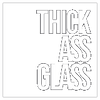You’d think pricing a bong would be easy, glass is glass, right?
But if you’ve spent any time shopping lately, you know that’s a myth. Some pieces are $40 and feel like toys, while others are $300 and still break on your second cleaning.
The truth? Most people have no idea what actually makes a bong good, let alone what it should cost.
A few weeks ago, I wrote a blog post titled “Why are bongs so expensive”. Some people may be inclined to call Thick Ass Glass a pricier option. That is, until they try one of our products. However, it’s still a valid question, especially when comparing brands.
This industry is packed with gimmicks, paper-thin glass, and branding smoke screens. I’ve been through all of it, tested the cheap stuff, redesigned the classics, and fought to make thick glass functional.
This isn’t about flashy logos or collector hype.
It’s about performance, longevity, and whether your lungs thank you after the hit.
A Straight Answer Up Front: What a Good Bong Costs in 2025
You don’t need a degree in thermodynamics to buy a decent bong, but knowing where your money goes helps. Here’s the quick breakdown: $30–$60 gets you the bare minimum.
Think silicone or thin glass with generic parts, mass-produced by people who’ve never hit one themselves.
Will it function? Technically. Will it last or hit clean? Not likely.
Step up to the $70–$150 range, and now you’re playing with something real, borosilicate glass, actual diffusion, maybe even an ice pinch.
These are bongs designed to be used daily, not just displayed or tossed in a backpack.
Push into $150–$300+, and you’re paying for engineering.
This is where airflow gets tuned, glass gets thick (like 9mm walls, 16mm bases), and each weld is dialed for strength, not speed. These pieces don’t just look solid, they are solid. They hit cooler, clean easier (if designed right), and won’t flinch at a knock on the counter.
So… is $100 too much for your first bong?
No. Not if it lasts five years, hits like silk, and doesn’t shatter the first time you breathe wrong near it.
In fact, the real question is, how much is it worth to avoid harsh pulls, constant clogs, and that creeping “did I just waste my money?” feeling?
What You’re Really Paying For (And When It’s Worth It)
Price tags don’t always reflect performance, but they should.
If there’s an 80/20 to bongs, I would say the 80 is what’s under the hood, and the 20 is the sticker price and how it looks on the shelf. The glass, the airflow, the engineering- these are the quiet details that decide whether a piece becomes your daily driver or ends up forgotten in a drawer.
If you’ve ever been burned by a “deal,” you already know: the wrong shortcuts show up fast, in flavor, function, and frustration. So let’s discuss where your money actually goes.
Material Determines How Your Bong Behaves
The backbone of any serious piece is its glass.
-
Cheap bongs often use soda-lime, fragile, thermally unstable, and prone to shattering just from rinsing with warm water.
-
Borosilicate, on the other hand, is lab-grade. It resists thermal shock, holds its clarity, and handles abuse that would turn thinner glass into shards. It’s the industry standard for people who actually use their glass.
Silicone and acrylic bongs might seem smart for the accident-prone, but they come with a cost you’ll notice in every hit: flavor distortion, uneven heating, and poor airflow.
What you gain in bounce, you lose in experience. That’s why TAG sticks to thick-walled borosilicate, it delivers where it matters most.
Filtration, Percolation, and Airflow
Percolators should enhance the draw, not choke it. But in the wrong setup, even “premium” percs turn smooth hits into cough-fests.
Helpful Resource -> Types Of Percolators
The trick is balanced diffusion, breaking the smoke into fine bubbles without killing airflow. That’s why engineered percs like showerhead or honeycomb setups consistently outperform generic multi-arm trees.
Take the TAG 16" Double Honeycomb with Splash Guard: it’s a perfect example of engineering done right. Two honeycomb discs create ultra-fine diffusion while maintaining natural pull, and the splash guard keeps water down, exactly where it belongs.
Why does that matter? Because airflow is everything.
A cheap $60 bong can hit worse than a dry spoon if it’s not designed properly. Once you experience a piece with tuned pull resistance and real diffusion, going back feels like inhaling through a clogged kazoo.
Build Quality and Design Engineering
A good bong is equal parts glass and structure. Joint misalignment, thin welds, uneven glass, all things you won’t notice at checkout but will notice when it breaks mid-cleaning.
That’s why we CAD-model every piece at TAG, down to the millimeter.
Do you want 9mm thick walls and 12–16mm bases?
That’s not overkill, it’s protection against the inevitable drop, the knocked-over coffee table, the rough roommate. It’s what makes the difference between replacing your bong and rinsing it off to go again.
Because if you’re asking, “Will this break in a week?”, then you already know what a bad answer feels like.
How Much Should You Spend Based on How You Smoke?
Not every smoker needs a $300 centerpiece, and not every budget bong is a steal.
The right price depends on how often you light up, where you do it, and what kind of session you’re chasing. One thing’s certain: the wrong bong will remind you of its shortcomings every single hit.
Thin glass, bad airflow, and harsh pulls will add up fast, and that “cheap win” becomes a constant frustration. So, what should you really spend? That answer changes depending on how you roll.
For the Casual Smoker Rejoining the Game
If you’re getting back into bongs after a break, or just smoke occasionally, a $60 to $100 budget will get you something reliable without overcommitting.
Look for a 10–12" beaker or straight tube, ideally with a diffused downstem and maybe a simple ice pinch. You don’t need extra percs or flashy gimmicks here, just a piece that won’t tip over, won’t clog instantly, and won’t destroy your throat on the first inhale.
Why not spend less?
Because that $35 acrylic special is likely thin, top-heavy, and made with poorly cut joints.
You’ll feel it in the airflow. You’ll taste it in every draw. And when it cracks from a lukewarm rinse or falls off your coffee table, you’ll realize it wasn’t much of a deal after all.
Daily Driver or Session Host?
If your bong is a daily tool, you need something built to survive the long haul.
Prioritize thicker glass (9mm walls, 12–16mm bases), a reinforced joint, and excellent airflow. A super slit downstem makes a massive difference in diffusion without adding drag or cleaning headaches.
Hosting sessions? Then a taller bong with multiple chambers earns its keep. You want cooler hits over longer pulls, especially with a room full of friends.
Just know this: more percs = more cleaning. If you hate maintenance, stay simple.
People ask, “Is a $200 bong actually better?”, and the answer is yes, when it’s designed for real use.
If it protects your lungs, survives drops, and still hits clean five years later, that’s not overpriced, that’s smart money.
Portability vs. Performance
On the go? You’ve got two choices: a mini borosilicate bong (~$45–$60) or a silicone piece.
One’s fragile but flavorful. The other bounces but tastes like regret.
Most experienced users eventually pick glass. Why? Because performance wins.
Performance vs. Hype: Are Expensive Bongs Really Better?
The short answer? Sometimes.
There’s a line between a functional masterpiece and a $400 glass statue that rips like a straw in concrete. The price tag alone won’t tell you which side it’s on.
Some expensive bongs earn every dollar with refined airflow tuning, well-placed percs, and flawless joints. These aren’t made to just look good, they’re built to hit effortlessly and survive daily use.
That’s engineering, not branding.
But others? You’re paying for the looks. Fancy colorwork, intricate necks, limited runs, cool to display, frustrating to use. If you’ve ever hit a gorgeous heady rig that left you coughing up regret, you know the difference.
At TAG, we’ll never sell you on hype. We’ll sell you on pull. A well-built beaker with super slit diffusion and thick-walled borosilicate will outperform most art pieces, every day of the week.
Flash fades. Function stays.
What Does a “Good” Bong Really Mean for You?
A good bong should be defined by performance.
For most serious smokers, $80–$150 hits the sweet spot: enough to get you true borosilicate glass, engineered airflow, and the kind of build that doesn’t flinch when life knocks it sideways.
Forget the gimmicks. What matters is how it hits, how it holds up, and how it fits your routine. Clean welds, a reinforced base, and percolation that cools without clogging, those are the signs of a piece that’s built for more than just looks.
At the end of the day, a good bong should work every single time, clean without a fight, and stay in one piece for years. That’s what we design for.
Check out our full lineup of bongs and compare prices between models to get a better feel of what you need to pay to get real quality.


